D-25: there were no alternatives!
I will express my opinion that almost all decisions in stories they were justified by some reasons unknown to us, and therefore I consider any of the decisions taken at that time to be correct, and therefore not subject to our discussions, especially among the “home-grown professionals”, that they lie on the couch, picking up my nose in the nose, talking about the fate of the world . Let me try to clarify this idea with the example of the allegedly unreasonable armament of the IC tanks of the “outdated” 122-mm D-25 cannon, and not the 100-mm of the “new” C-34.
So, on September 4, 1943 issued a decree of the GFCS No. 4043CC, which prescribed the adoption of heavy IP tanks for the Red Army and mass production. But it soon became clear that their weapons from the D-85T 5-mm cannon, which was considered the height of perfection in the spring, suddenly became not powerful enough. And there were good reasons. The fact is that the main purpose of the heavy tanks of the Soviet army was not only to destroy their own kind, but also to help break through the especially fortified enemy defenses. And in the 85 gun kit in the 1943, there were only shots, mostly borrowed from anti-aircraft artillery, that is, with fragmentation, fragmentation-remote (high-explosive) grenade, shrapnel and armor-piercing projectile.
The 85-mm armor-piercing tracer until the summer of 1943 could successfully fight all German tanks, but when the Tiger and Panther entered the battlefield, the armor of which the gun pierced (normal penetration of the 100 mm was provided) distances 600-800 m and closer, but at these distances armor tank IS did not provide him with reliable protection against armor-piercing shells of the new 75-mm and 88-mm German tank and anti-tank guns.
The absence of 85-mm cannon shots in the ammunition with an effective high-explosive grenade significantly reduced the combat value of a heavy tank for breaking through the enemy’s prepared defense lines, since even a tree-and-earth dugout with two rolls could withstand a fragmentation 85-mm grenade.
Thus, immediately after the birth of a new heavy tank demanded more powerful weapons.
Consider which tank artillery systems of high power were in the USSR at that time (1943 at the end of October) so that they could be quickly adapted in the turret of a new heavy tank.
1. 106,7-mm gun ZIS-6 sample 1941, its production was prepared in 1941, the plant number 92. The gun was high-tech, had mastered the industry in 1939, high-explosive and armor-piercing shells. Among the drawbacks of the gun are the large size of the breech, which did not allow it to be installed in the turret of the IS tank (or KV-lc) without reworking, separate loading, slowing down the rate of fire, and most importantly, the 1943 didn’t massively produce ammunition for it.
2. 121,9-mm howitzer U-11 of model 1941. Howitzer was developed by designers of Uralmashzavod (UZTM) V. Sidorenko and N. Usenko in October-November of 1941 and was tested in 1942-43. in the tower of tanks KV-9, EC-2 (Object 234) and chopping SU-122М. However, by the fall of 1943g. the howitzer was never brought. Constantly revealed any structural defects. Separate loading of the U-11 also led to a low rate of fire, and if necessary, enemy tanks could only be fought with cumulative (in terms of those years, “armored” projectile) still unreliable in 1943. The howitzer had a very small direct shot range (less than 300 m), which made it difficult to fire from a moving and point target (tank, supervisee).
3. 121,9-mm howitzer D-6 design bureau of plant No. 9 of model 1943. Further development of the howitzer U-11 using the installation places 85-mm gun D-5. D-6 could be installed without modifications in the EC-85 tower. But as a tank gun, it had the same drawbacks as the Y-11, besides it broke down in state tests.
4. The 121,9 / 152,4-mm C-41 tank howitzer of the 1943 model. The Howitzer was developed by TsAKKB in two versions to arm the KB-1C, turning it into a kind of artillery tank KV-2. However, this howitzer also had the same drawbacks as previously discussed. In addition, an additional brake for adopting a C-41 howitzer in the 152,4-mm version was the obligatory presence of a muzzle brake, which the military categorically disagreed with.
That's all tank artillery systems of high power, which were available at least in the prototype and were allowed to test at that time. As we see, none of them without significant rework (often comparable with the design of the parts of the gun again) was impossible or impractical to install in the IC.
However, an experienced "122-mm gun D-2 (L-19 lite)", which has satisfactorily passed the first stage of factory tests, was ready. The gun differed from the A-19 in that it had the M-30 howitzer gun carriage and, therefore, reduced combat weight, as well as a small length and force of recoil. The gun was recommended for use, but was rejected by the NKV commission because it had a muzzle brake, which, with a powerful charge, had a “large unmasking effect exceeding that of all known artillery systems” (including the X-NUMX-mm howitzer D-152).
And when Z.Kotin turned to OKB-9 with a request to consider the possibility of installing an 122-mm cannon into the turret of an IS tank, they called it “hit the address”. Of course, the D-2 gun had separate loading, as was the ZIS-6 and all the considered howitzers, but at the same time its shot was mastered by industry and was mass-produced. The high-explosive effect of the gun was not in doubt, the range of the direct shot was comparable to that of the “Tiger” (if not more). The fact that it was recommended for commissioning was also played in favor of this weapon and almost all the ground tests with the X-NUMX-mm howitzer D-152 (no modifications were required) passed without breakdowns.
To install the D-2 into the tower of the IS tank, it had to be redesigned somewhat, but the preliminary design was completed on the entire 10 days (as indicated in F. Petrov’s note). Despite the fact that the military continued to protest strongly against adopting a tank gun with a muzzle brake, V. Malyshev supported the decision and, with the support of D. Ustinov, reported to I. Stalin about the advantages of quickly adopting an 122-mm tank gun. the guns. The leader considered his arguments reasonable, and the NKV received a go-ahead for the manufacture of a prototype 122-mm tank gun D-2-5 (A-19 tank) to 11 in November 1943.
The short meeting of the State Defense Committee, which followed soon, finally decided the fate of the armament of the IS tank. The voices of those present were divided. Some defended the NNU 100-mm gun with the ballistics of the B-34 naval guns and unitary ammunition (C-3), which had just been proposed by the plenum of the NKV, and the others with the powerful 122-mm cannon, which can not only use tanks with one blow but also pillboxes. And the decision of Stalin, speaking at a meeting on the side of the 122-mm gun, many call today stupid and short-sighted.
No, dear critics, this decision was very far-sighted at that moment. Let's put ourselves in Stalin's place. He knew well what it means to develop a fundamentally new weapon, perfectly represented (and not theoretically) what forces and means it requires. So decide for yourself what's best: the 100-mm gun, even with a unitar and theoretically a little more powerful for fighting tanks, but only after several months, when an armor-piercing projectile will be mastered for it (and in fact more than six months have passed), or 122-mm, even with the muzzle brake and separate loading, but is ALREADY READY AND SUCCESSFULLY LAST THE FIRST TEST STAGE? And most importantly, the 122-mm tank gun had a lot of common nodes with the serial 85-mm D-5 and differed from it mainly in the barrel and breech - the recoil mechanisms were worked out, and it was their name that always had major problems in the guns of this caliber.
Yes, and Stalin did not reject the 100-mm gun. Moreover, 27 in December 1943 of the GFCS adopted Resolution No. 4851 on the development of a heavy IS tank for armaments and medium-sized anti-aircraft 100-mm guns.
“It’s more detailed from this place,” will exclaim a tank theoretician. “Why didn’t they?”
Let's deal with this.
Implementing the GFCS resolution. for the 20 February 1944 in the USSR should have been prepared for testing an IS tank and an average SPG with an 100-mm gun. Since the project of such a gun was made by TsAKKB, they were guided precisely by its products - the C-34 cannon. In it, the designers of the TsAKB, for ease of loading, provided for a new placement of the loader - to the left of the gun “under the right hand”. It was this adjustment (I’ll add from myself — quite reasonable to my unenlightened view) that was the first stumbling block about which the CACB’s normal relations with the tank crews were broken. After all, the tankers had to redesign the entire combat compartment of the tank, develop a fundamentally new tower for it, change the casting molds, the assembly technology ... But most importantly, nobody warned them about this beforehand! And it was not easy to do all this, because it meant to hastily rebuild almost all reservations! Arguing parties began to accuse each other of not fulfilling the decision on time. But even this was not the main factor in the refusal of the EC-100 and SU-100 into service, but the fact that in February 1944, the GUSH C-34 DIDN'T SUPPORT TESTS! The recoil devices failed, and it was too early to talk about the beginning of its mass production at that time.
By the end of February, 1944, the OKB No. 9, offered its own version of the X-NUMX-mm tank gun, the D-100. It was designed based on the design of the D-10 and D-5. but unlike the prototypes, the gun had new recoil mechanisms that needed fine-tuning. Naturally, manufacturers of tanks and ACS. ChKZ and UZTM were more inclined to use this tool, since it did not require fundamentally redoing the fighting compartment.
3 March 1944 began the tests of the D-10 in the artillery missile. But the test program was not sustained, and the gun returned to the Design Bureau for finalizing the design. The D-10 tests began and interrupted several more times, but only on July 2 the test program ended satisfactorily, and on July 3, the GFCS by decision No. 1944 adopted the D-6131С gun for armament of the SU-10.
Experiments with the tank 100-mm gun continued until the end of July, until they were successful. Plant No. 9 could have mastered the X-NUMX-mm D-100 cannon in the series by September 10, all the standard equipment adopted by the customer gradually arrived at Uralmash for installation in the SU-1944, but self-propelled guns appeared at the front only at the end of the year. There was one feature that strongly slowed down the appearance of 100-mm tank guns. In their ammunition was not armor-piercing projectile! Its release was mastered only in November 100, when the formation of the first parts with the 1944-mm artillery systems began.
Now let's see what gave such a rearmament tank? Let's go back to the theorists. Their arguments are:
1. A unitary shot, which means a high rate of fire.
2. Smaller caliber, which means more ammunition.
3. Great armor penetration.
Theoretically, that's right, but in practice ...
It is difficult to object something to the first argument, because indeed when firing from the spot the 100-mm gun gives some advantages over the 122-mm. But we should not forget that fire from tanks was carried out in combat most often from short stops, that is, the loading was carried out in motion, and in this situation, firstly, fast reloading with heavy and long ammunition (shot) is almost impossible, and secondly, a separate shot (like two relatively short and less heavy cylinders), according to testers, was even more comfortable when choosing the type of projectile in a close fighting compartment. So in most cases, the practical rate of fire of the EC-122 (1,5 - 2,5 rds / min) was not very different from the practical rate of fire of the EC-4 (245 Object), which was 3-3,5 rds / min. But I repeat, a unitary shot is a pretty strong argument.
The second argument - about more portable ammunition also crumbles when tested by practice. After all, the advantages of separate loading in the close combat compartment of a tank consist in the fact that projectiles can be stored separately from shells with charges and thus, in a combat compartment of a complex form of an IS tank, they could be placed more rationally.
Actually, this is exactly what happened, since the BC of the EC-122 tank consisted of 28 shots, and the EC-4 (245 Object) with the 100-mm D-10 cannon — 29 shots. The CACB, however, managed to bring the EC-5 tank (248 Object) to the 36 shots through a long canter, but according to testers' testimonies, it was not possible to use six shots located in front of the hull. So here the gain was very conditional.
Well, about heat resistance. Again, speaking in favor of the 100-mm gun, the theorists say that the D-100 X-guns have more armor penetration. But they say this as an axiom, based on the data given in the 10-mm 100-s gun manual. But in the war, these figures were slightly different.
Compare, here are the calculated values of the permeability according to the NKV data from 4 in May 1944 g:
100-mm | gun D-10 | 122-mm | gun D-25 | |||
Projectile weight | 15.6 kg | 25 kg | ||||
Early speed | 890 m / s | 800 m / s | ||||
Meeting angle | 0 | 30 | 55 | 0 | 30 | 55 |
300 m | 164 | 136 | 76 | 160 | 130 | 72 |
500 m | 159 | 132 | 73 | 155 | 127 | 70 |
1000 m | 149 | 122 | 68 | 144 | 117 | 65 |
1500m | 138 | : 12 | 52 | 133 | '07 | 60 |
2000 m | 127 | 103 | 57 | 122 | 98 | 55 |
It is easy to see that even the theoretical gain of the 100-mm gun in the resistance to performance was about 5 mm, all other conditions being equal. And I emphasize the word "theoretical." It is precisely because in 1944 it turned out that these theoretical calculations very poorly fit into practice.
After all, armor penetration calculations were carried out for viscous Russian armor mainly of medium hardness and mostly normal, and since the summer of 1944, the Germans used mainly armor of high hardness, which has become somewhere more fragile, and somewhere more solid, and for its penetration The first place was no longer a high initial velocity, but a large mass of projectile. This led, for example, to the fact that the frontal armor of the Panther tank (inclined to the 55 angle to the horizon) was poorly beaten by high-speed 85-mm D-5-85BM munitions, but it was easily penetrated by 122-mm projectile from fantastic distances ( with 2000-2500 m), and if the projectile and ricocheted - cracks and breaks remained in the armor.
And in conclusion, in order not to be unfounded, I will give a selection of several documents of the RSAE about 122-mm and 100-mm tank guns:
Ex. № ______
Malyshev (convocation)
Ustinov
Fedorenko
Yakovlev
Kirpichnikova
Borisov
Petrosyantsu
Vannikov
______________
Term three days
* * *
By installation on tanks 100 mm IP gun
D-1OT, factory design № 9 NKV
From 1 to July 6 On the Gorokhovetsky ground of GAU KA, repeated tests of an IC tank armed with an X-NUMX mm D-100T gun from factory No. 10 NKV (designed by t. Petrov) were carried out.
The 100 mm gun D-10T of plant No. 9 NKV, installed in the IS tank, passed the ground tests, and according to the conclusion of the commission that conducted the tests of the tank, it can be recommended for adoption by the Red Army.
The installation of the 100 mm cannon of factory No. 9 in the IS tank provides the following advantages compared to the 122mm D-25 gun now installed in the IS tank:
1) The target rate of fire of the 100 mm gun from the IC tank reaches from 5 to 8 rounds per minute against the 2-3 rounds of 122 mm D-25 gun.
2) Ammunition in the tank ammunition shells for 100-mm gun 29 pcs. shots against xnumx pcs. for 28 mm cannon D-122
3) The absence of a muzzle brake on the 100 mm gun improves shooting conditions and the work of the gunner-gunner, compared to the 122 mm D-25 gun.
4) The weight of an IC tank with a 100 mm gun on the 500-600 kg is less than with a 122 mm gun. This economy in weight can be used to increase the thickness of the armor of vital parts of the tank (nose, turret, tanks).
5) Due to the smaller size of the breech of the 100 mm gun, the working conditions for the crew of the IC tank will be improved when the 100 mm gun is installed.
At the same time, the armor penetration of the 100 mm D-10T cannon at a distance of a tank battle (to 2000 met.) Is not only not inferior, but even gives some advantages over the 122 mm D-25 cannon.
Considering all the above, and especially the good rate of fire of the 100 mm gun and an increase in ammunition, which will significantly improve the combat power of the IS tank, I consider it necessary to start in September-October of this year. Install X-NUMX mm D-100T guns instead of 10 mm D-122 guns.
Neither the Narkomtankprom nor the NKV, this measure will not meet any serious difficulties.
I enclose a 2 photo of an IC tank with a 100 mm D-10T gun
Waiting for your instructions.
pp V.Malyshev
* * *
Taken by "HF"
USSR
Comrade USTINOVA D.F.
On your instructions, we report on the question of replacing the D-25 cannon with the D-10T cannon in the IS tank:
1. Given the high rate of fire of the D-10 compared to the D-25, mainly due to the unitary cartridge, replacement is advisable, but only if there is a spent armor-piercing projectile equivalent to the armor penetration rate of the D-25 projectile.
We currently do not have data on the availability of such a projectile in production.
2. We consider it necessary to keep the D-25 cannon in the heavy tank "EC-2". The latest tests at the ANIOP gave firing rates per minute in 4-6 - the results are good.
3. The plant in August - September finishes the entire pre-production of the D-10C.
4. In October - November, the production can be transferred entirely to the D-10T system instead of the D-25 system.
In October, you can determine the release of D-10T - 150 pcs., In November - 2 50 pcs.
6. To ensure this program, the plant requires, in addition to the full implementation of the GFCS solution for D-10С - 4, 600x6000 shearing-turning machines two support and two vertical-milling machines №6.
7. From October, the production of D-25 should be transferred from plant number 9 to plant number 75 or number 221.
Signed:
Mirzakhanov
Honor
Fratkin
Ryzhkov
Petrov
8. VIII-44
***
S.SECRETNO
In accordance with your instructions regarding the installation of D-UT guns on the 100 mm IS tanks, the plant design No. 9 NKV has the following to you:
1. At present, IC tanks armed with an 122-mm cannon successfully reflect counterattacks of enemy tanks of all types at all distances of a tank battle (i.e. before the 1500 mtr).
2. The armament of a part of the IS 100mm cannon DR-UT will inevitably create difficulties with the supply of breakthrough tank regiments.
3. Replacing X-NUMX mm tanks with D-122 cannons and 25 mm cannons will have a negative impact on the firepower of a heavy tank when fighting enemy manpower and long-term fortifications, since the fragmentation and high-explosive effect of the 100 mm gun is significantly reduced compared to 100 mm cannon D-122.
4. Ammunition 122 mm tank gun D-25 is 28 shots, and 100 mm gun D-10 - 29 cartridges. Thus, a significant increase in ammunition does not occur.
5. Charging in combat conditions it is difficult to ensure fast loading of elongated cartridges of caliber 100mm. In addition, when conducting intensive fire from a semi-automatic large-caliber gun, there will be a rapid pollution of the tank compartment, which will require firing for a while. So in this matter, the real rate of fire of the D10 cannon will be significantly reduced compared with the landfill data.
Based on the above, I consider it inappropriate to replace the D-25 tank guns with the 100 mm guns of the D-10 tank guns of the plant No. 9 at the present time.
pp Fedorenko
right (signature)
* * *
Ex. No ...
tov SATEL E.A.
REPORT NOTE
As shown by the experimental shooting at the German Panther tanks, carried out at the Cuban training ground of the GBTU, the tested cannons, in order of the effectiveness of the projectiles on the frontal part of the Panther tank, are arranged in the following order:
1. 122mm tank gun "D-25" (plant number 9) having the same ballistics with guns: 122mm A-19, 122mm D-2 plant No. 9 C-4 TsAKKB, namely: the initial velocity v = 780-790 m 25 projectile kg. This gun punches the forehead of the Panther confidently at a distance of 2500 mtr., And this is not the maximum distance.
2. 100mm tank gun D-10, having the same ballistics with the gun 100 mm BS-3, namely: initial speed v = 890-900 m / s. with 15,6 projectile kg
This gun punches the forehead of the Panther at a distance of 1500 mtr., And this is already the limit.
3. 88-mm German cannon, with an initial speed of 1000 m / s with an 10 kg projectile, punches the “Panther” forehead to a distance of only 650 meters.
Frontal armor "Panther" has a thickness of 85mm and a slope to the horizon 35grad. Consequently, when shooting at the Panther tank, at the specified distances, at the meeting point for the purpose, the projectile's trajectory is inclined to the horizon at an angle slightly different from zero, and the angle between the projectile axis and the normal to the armor (the encounter angle) is close to 55 deg.
These results are preliminary, because during the experiments guns of different wear were used: 100 mm D-10 which made 400 shots, and 122mm D-25 new. But the resulting difference is so significant that it is difficult to expect large corrections in the results.
The method of assessing armor penetration that has been adopted up to now at meeting angles from 0 hail to 50 hail is insufficient to apply to anti-tank guns.
Therefore, in our opinion, it is necessary to reconsider the question of the most advantageous, for the fight against tanks, the caliber of guns.
If we bear in mind the fight against Panther tanks, then, as Cuban experiments show, 122mm gun D-25 (v = 780-790 m / s), g = 25 kg.) Turns out to be more profitable than 100-mm gun D-10 (v = 890-900 m / s d = 15,6 kg.).
Similarly, it should be considered as a more profitable 122-mm cannon on a wheeled carriage (А-19, Д-2 of plant number 9, С-4 ЦАКБ). The 100 mm BS-3 gun is less profitable.
As you know, currently there are two well-tested 122mm field guns, which are lighter compared to A-19 weights, and with the same ballistics, namely:
1. The 122 mm gun of the C-4 design / CACB is supposed to go on the ground tests.
The C-4 cannon has a lot of nodes in common with the 100 mm BC-3 cannon and its production could be set up on the same base as the BS-3 cannons.
Consequently, for the same gun, the question is only in the favorable outcome of the field and, possibly, subsequent military tests.
2. 122mm gun D-2, factory design number 9, repeatedly withstand ground test. The 4 series of pieces D-2 is preparing soon for military trials. I believe that it is necessary to urgently consider the issue of a possible production base for the D-2, in case C-4 does not pass the relying tests.
The second fundamental question arising from the Cuban experiments is the question of high initial velocities, in particular, 85-mm guns with an initial speed of 1000-1100 m / s.
The experience shows a relatively small effectiveness of the 88mm projectile of the German cannon, in the German Panther tank.
At the same time, it is known that such an 85-mm gun is obtained, in terms of weight and dimensions, approximately equivalent to an 100-mm gun with an initial speed of 900 m / s.
Testing 85mm guns with v = 1000-1100 m / s. It is conducted both at TsAKKB and at plant No. 9, and yet its comparative effectiveness on a real German tank becomes doubtful, especially since we cannot put such a gun in dimensions of a tank tower smaller than the D-100 (for or C-10).
On this issue, it seems that, if it is appropriate, after the end of the Cuban experiments, and if the final results confirm the existing ones, to convene a special meeting and to plan on it further ways of working on guns with high initial speeds.
The only undoubted today is the need to increase the initial speeds for anti-aircraft guns, in which increasing the initial speed dramatically increases the ceiling and reduces the flight time.
We ask your relevant instructions.
REPAIR CHIEF OF TECHNOLOGY NKV
/ COLORS /
START SECTOR OF EXPERIMENTAL STRUCTURES:
* Style and spelling of documents saved
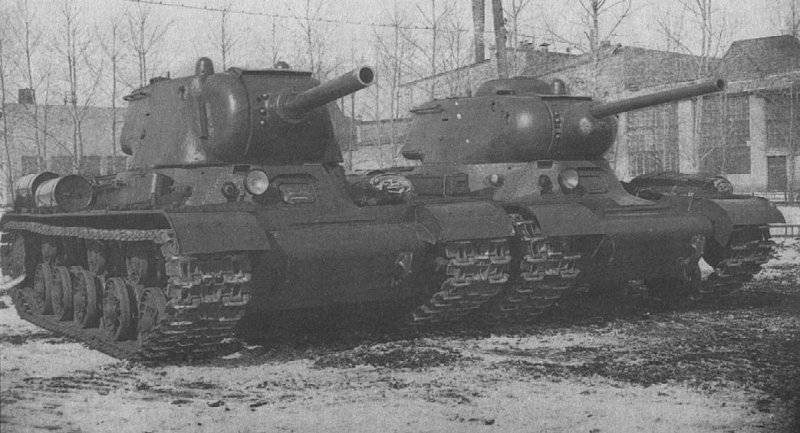
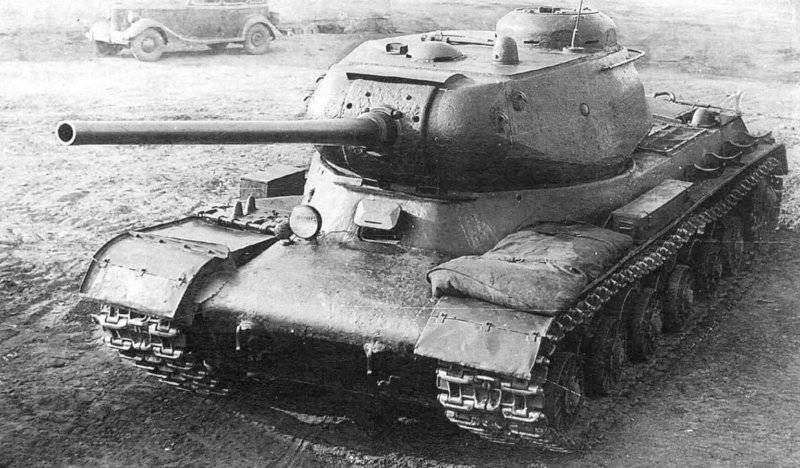
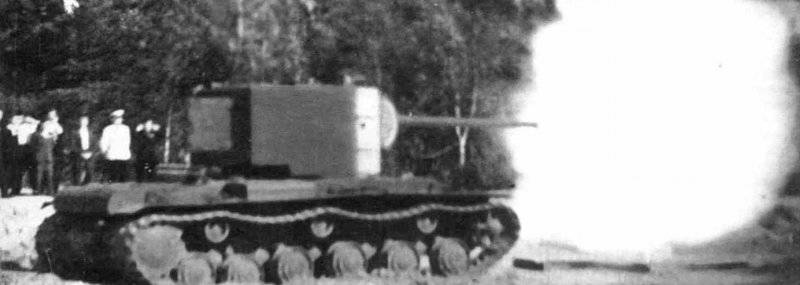
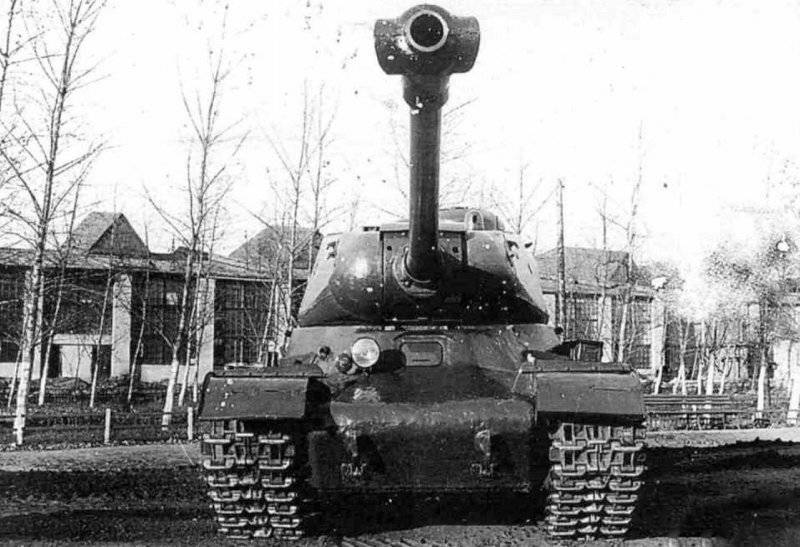
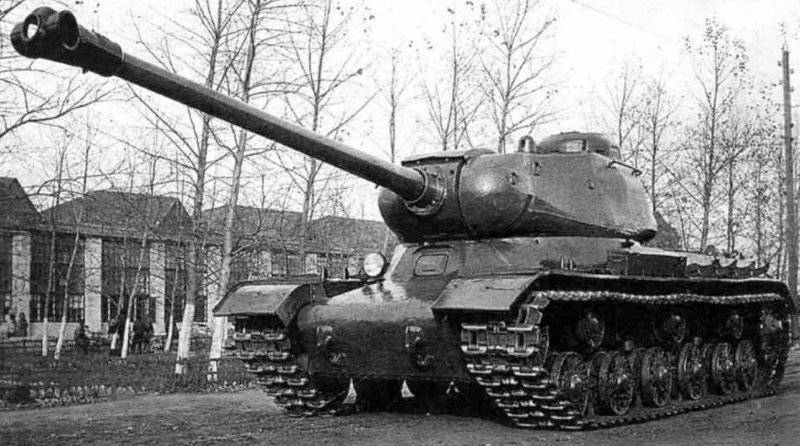

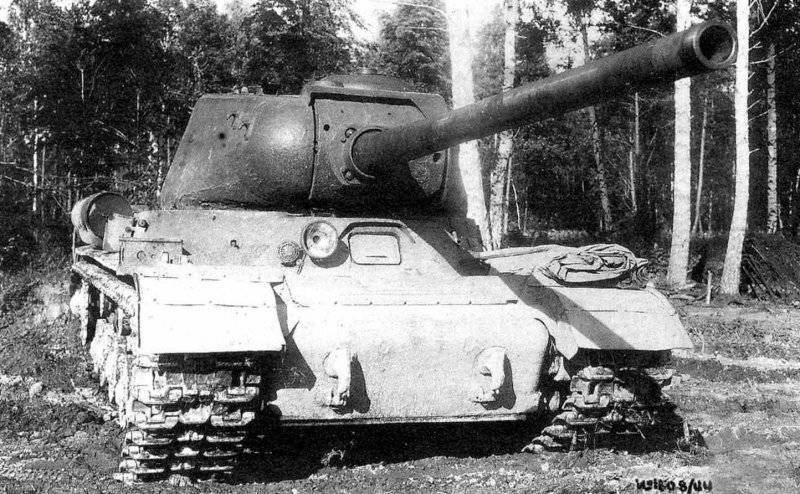
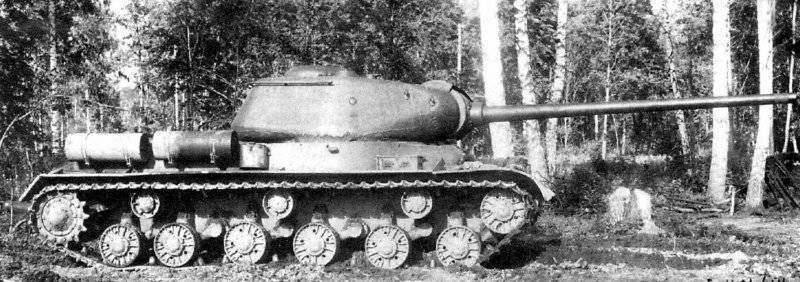
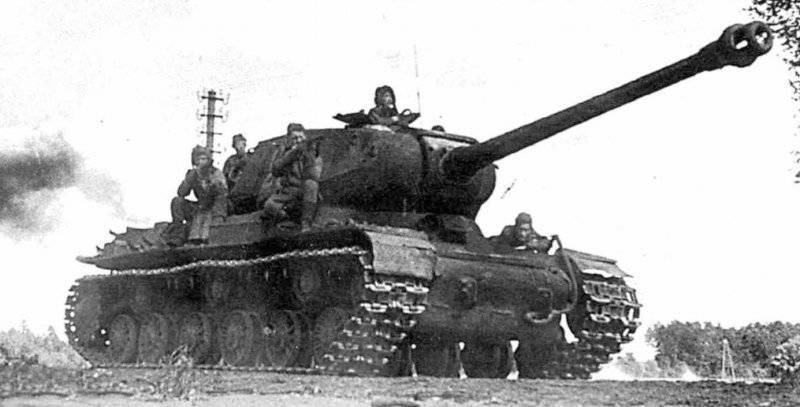
Information